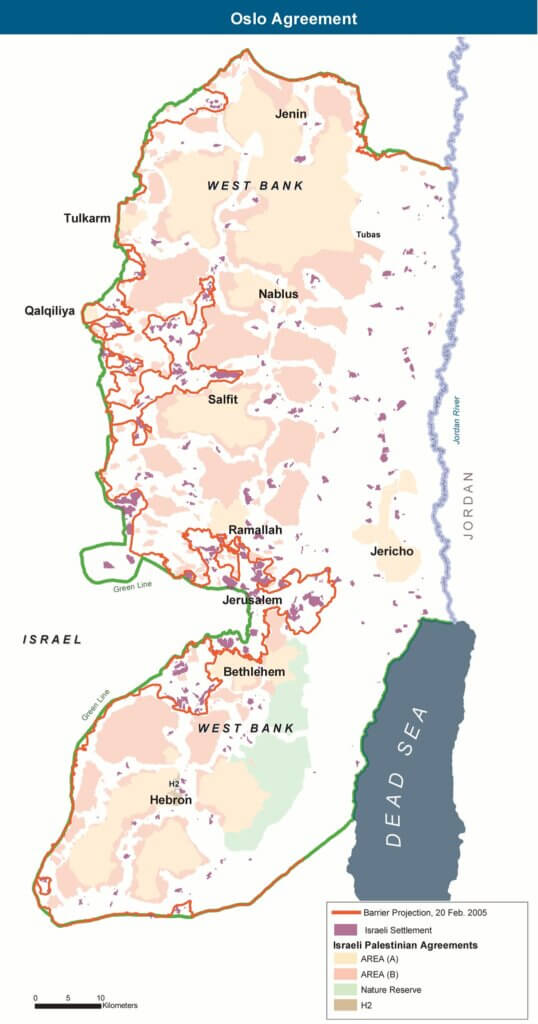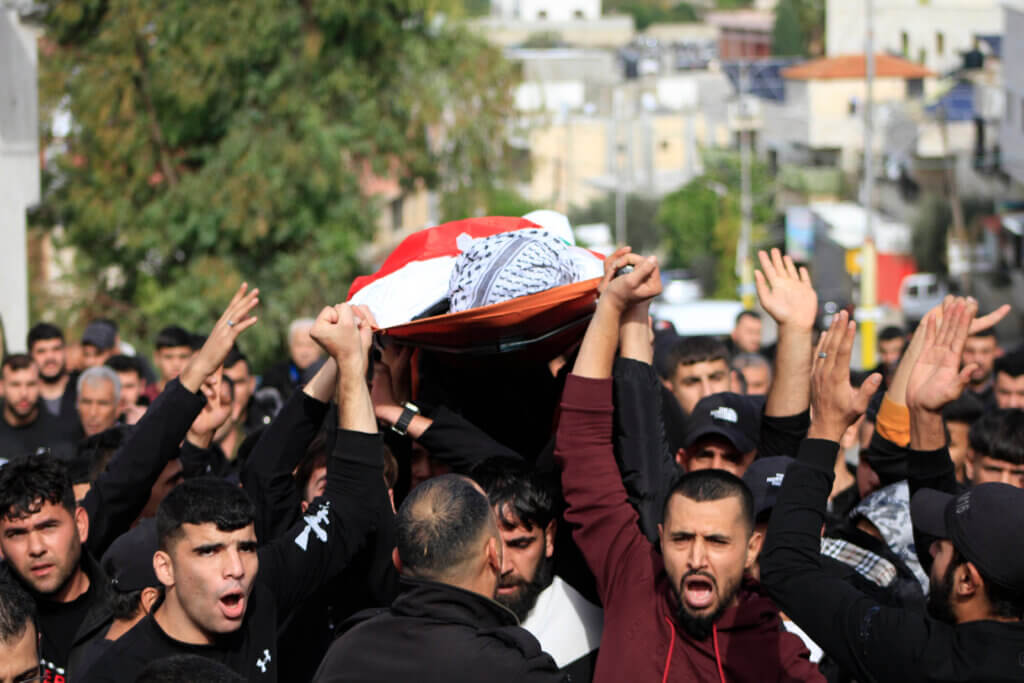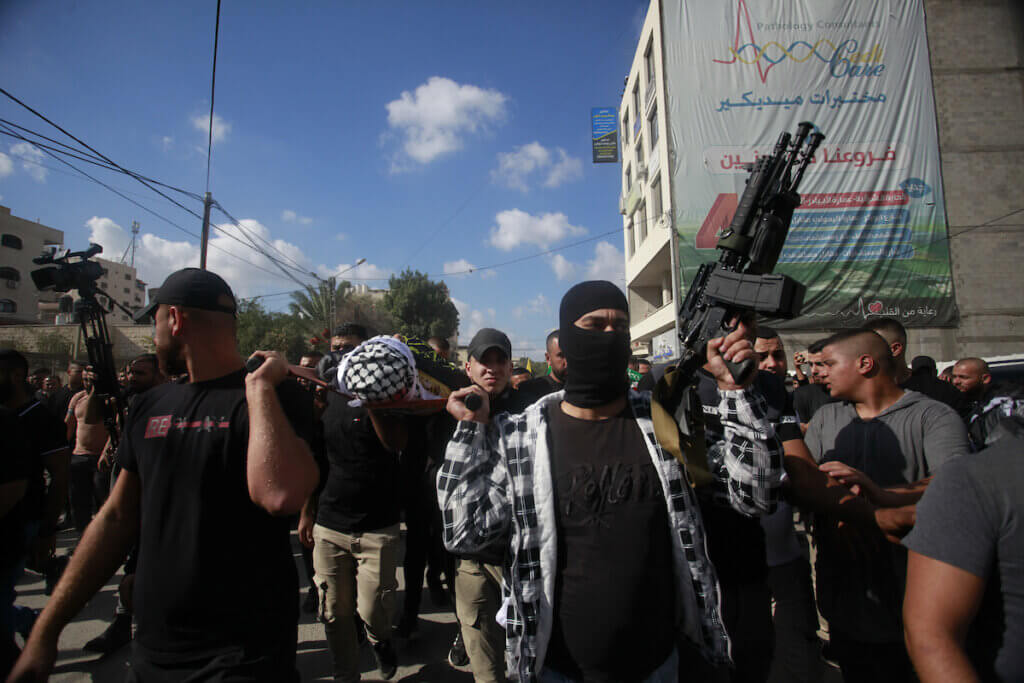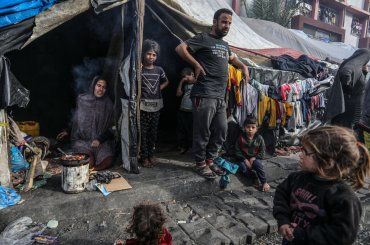In the early morning of Thursday, January 25, Israeli forces withdrew from the city of Jenin in the northern occupied West Bank following the army’s destruction of the city’s infrastructure and monuments of martyrs that lined the streets. Shortly after the withdrawal, an Israeli special forces unit raided and besieged a home in the small village of Bir al-Basha, south of Jenin, leading to clashes between the invading forces and a 20-year-old Palestinian man inside the house.
People in the village initially believed that the raid was a routine operation to arrest the young man, a former prisoner named Wisam Khashan. However, after Khashan was killed, the true narrative of the ambush emerged. Unbeknownst to his family, the martyr was, in fact, a resistance fighter who had been part of numerous armed confrontations attempting to repel Israeli army incursions into Jenin in recent months.
Earlier that day, prior to his assassination, Khashan had headed into the city as the army began its raid. There, he confronted Israeli military vehicles, firing a hail of bullets towards the army convoy. According to a local source, after the forces withdrew, Khashan returned to his village, just 15 kilometers (~9 miles) outside the city. On his way back, he was followed by an Israeli drone that tracked his movements up until the moment he returned to his house. Shortly after he arrived home, Israeli special forces raided his house and assassinated him.
Though countless Palestinian resistance fighters in Jenin have been targeted and killed by Israeli forces over the past few years, Khashan’s assassination is notable in that it points to the growth of the Palestinian resistance across the West Bank. In cities like Jenin, resistance fighters have typically found safe haven within the city boundaries or inside the city’s refugee camp — a nucleus of armed struggle. However, Wisam Khashan’s story, one of a young man from a village traveling to and from the city center to fight and subsequently being tracked down and assassinated, made waves in the community.
And there are now many stories similar to Khashan’s, of young men from villages and towns and otherwise “quiet” cities who are taking up arms against the Israeli occupation.
A few weeks before the raid on Bir al-Basha, Israeli forces raided the village of Sir, another small village with a population of fewer than a thousand inhabitants located south of the city of Jenin. The raid, which took place on January 5, aimed to arrest a group of young men wanted for their involvement in student activism at one of the universities.
Following the failed arrest operation, armed clashes erupted on the outskirts of the village as the army withdrew. During the clashes, an explosive device detonated near one of the Israeli military vehicles, leading to the injury of a soldier, according to an Israeli army statement. The army was forced to dispatch a helicopter to evacuate the injured soldier.
The armed clashes shocked the residents of the tiny village, who, despite living in the Jenin area, were accustomed to relative quiet. A resident of the village told Mondoweiss that it was the first instance of armed clashes in the village since the First Intifada in 1987, and the army’s incursion into the village was described as the largest since the Second Intifada in 2000.
The events in Sir and Bir al-Basha paint a story of a larger pattern that has taken shape primarily in the northern West Bank. Although cities like Jenin, Nablus, and Tulkarem have emerged as hubs for armed resistance and Israeli repression over the past two years, since October 7, a new resistance landscape is emerging outside of these hubs. As Israel moves towards a more aggressive military approach in an attempt to quash armed resistance, the resistance is adapting and changing with it.
The anonymous resistance fighters of Qalqilya
One example of an emerging resistance group can be found southwest of Jenin and Tulkarem in the city of Qalqilya. One of the smaller cities in the West Bank, Qalqilya sits right on the Green Line, the demarcation line between the occupied West Bank and ‘48 Palestine (present-day Israel).
Qalqilya and its surrounding towns and villages have largely been considered “under control” and “contained” from an Israeli security perspective. It is surrounded on most sides by Israel’s separation wall and Israeli settlements and is “only a 20-minute drive to Tel Aviv,” as one resident put it, even though Tel Aviv and the other side of the wall are effectively inaccessible to the Palestinians in Qalqilya. A majority of the district’s land also falls under “Area C,” which is under complete Israeli security and civil control.

Due to its geography and the entrenchment of the Israeli security and settlement apparatus in the area, Qalqilya has not typically been a conducive environment to the formation and development of armed resistance groups.
But since October 7, Qalqilya has witnessed armed clashes for the first time in more than a decade. Every Israeli incursion into the city over the past few months has been accompanied by armed clashes with Palestinians.
According to sources, unlike in Jenin and Tulkarem, where the resistance can exist and operate openly within the boundaries of the refugee camp, resistance fighters in Qalqilya must operate in such secrecy that their identities remain largely unknown, even to Israel.
Representative of this reality is the story of the martyr Alaa Nazzal, whose identity remained unknown for a whole year even though he was wanted by Israel. For most of that time, people only knew him by the nickname “Abu George,” and his picture did not circulate on social media until after his martyrdom.
“Abu George” was largely attributed to the renewal of armed clashes in Qalqilya and is one of the founders of the “Lions of Glory Brigade” in Qalqilya. His martyrdom seems to have changed and inspired Qalqilya as many of Nazzal’s friends and community members decided to take up arms and follow in his footsteps.
Today, the Lions of Glory Brigade, affiliated with the Al-Aqsa Martyrs’ Brigades, the military wing of Fatah, leads the confrontations against invading Israeli forces in Qalqilya.
“The [Israeli] occupation periodically tries to arrest some of these fighters but is surprised by the emergence of others joining the resistance,” a source close to the Lions of Glory Brigade told Mondoweiss. What makes Qalqilya different, he noted, is that while some fighters do operate within the organizational structure of the brigade, many, like Wisam Khashan in Bir al-Basha, also operate individually, making it more difficult for the military to track their plans and movements.
Sources told Mondoweiss that fighters in Qalqilya primarily emerge at the moment when Israeli forces carry out a military operation in the city, sparking armed clashes in various locations. The fighters also conduct shooting operations toward the settlements and throw explosives at a permanent Israeli military checkpoint north of the city.
Since October 7, Israeli forces have been raiding the city of Qalqilya every week, seemingly in an attempt to flush the fighters out, hinder the establishment of a more organized armed resistance structure in the city, and prevent it from turning into a Jenin or Tulkarem model.
Nevertheless, the fighters in Qalqilya seem to be adapting, not only in the decentralization of their brigade but also in the type of weapons they use. Due to its isolation from other Palestinian areas, the transfer of weapons into the city is nearly impossible. This has led most resistance fighters to use locally manufactured Carlo-type weapons or homemade explosives.
The use of improvised explosive devices (IEDs) has become increasingly popular among the decentralized militia-like resistance groups across the northern West Bank. Popularized most recently in the refugee camps of Jenin and Tulkarem, local resistance brigades in Qalqilya, Tubas in the Jordan Valley, and the rural areas around Jenin have deployed the use of locally made explosives as another means of confrontation.
The countryside in armed confrontation: The growth of the ‘Azzun Brigade’
On Route 55, a highway connecting the northern and southern parts of the West Bank, lies the entrance to the town of Azzun, situated to the east of Qalqilya. Azzun, like many Palestinian villages in the north, is surrounded by Israeli settlements. For years, it has been common practice for the youth of the village to throw stones and Molotov cocktails towards the Israeli military and settler vehicles that pass through the area on Route 55.
Nevertheless, like the nearby city of Qalqilya, Azzun is considered a “peaceful town” from the Israeli security perspective, located in an area under full Israeli control and surrounded by settlements from all sides. Israel’s ability to “secure the area” is deemed crucial, and due to Azzun’s proximity to Gate 9, the main gateway to Israeli settlements in the northern West Bank, Israeli forces can reach the heart of the town and shut things down within minutes.
Except for the youths who throw rocks and the occasional Molotov cocktail, Azzun hasn’t typically presented a “security threat” to the Israelis. That all began to change after October 7.
“Resistance in Azzun used to be non-armed, involving stones and Molotov cocktails. Then everything changed after October 7…people felt suffocated; all roads between cities were closed, and workers were prevented from entering the occupied ‘48 territories for work,” a resident of Azzun told Mondoweiss, saying that the youth of the village became increasingly disillusioned and frustrated with what they were witnessing both in Gaza and in the West Bank.
As the youth became more frustrated, the nature of Azzun’s resistance to the Israeli occupation started shifting when young men in the village began to take up arms. Whispers began to circulate of the emergence of the “Azzun Brigade.”
According to sources close to the brigade, the brigade consisted of friends from the town who refused to align themselves with any political affiliation. They relied on their own incomes to finance the brigade and would carry out shooting operations toward the settlements that surrounded Azzun while using their weapons to confront Israeli forces during raids.
Just as soon as the youth of the village began to resist, Israel intensified its crackdown. In the three months after October 7 alone, eight Palestinians were killed by Israeli forces in Azzun, including several resistance fighters who were assassinated in targeted Israeli operations.
“October 7 is not the sole reason for this situation [the rise of armed resistance], but the brutality of the occupation in dealing with Palestinians. There are more martyrs in Azzun who were not resistance fighters and yet were executed. This has made the youth harbor even more resentment toward the occupation that kills us,” the resident, who requested anonymity, told Mondoweiss.
On January 2, Israeli forces raided the village, assassinated four young men, and confiscated weapons from them. The young men were allegedly responsible for carrying out a double operation, using an IED to detonate an Israeli military vehicle and targeting Israeli soldiers with gunfire. The assassination of the four young men sent shockwaves through the small town.
A young man, S., one of the close associates of the fighters in the town, told Mondoweiss, “The youth who were assassinated were still at the beginning of forming the resistance brigade. Their assassination has impacted the rest of the youth in one way or another.”
“Before the assassination, the determination of the youth in the town was stronger; approximately 60-70 young men were waiting for the Israeli raids so they could engage in resistance,” S. said. However, after the assassination of the four young men and the arrest of five other resistance members in the town, S. says the youth now live in fear of a similar fate.
When asked if this means the resistance stops when Israeli forces invade the town, he answered without hesitation, “No.”

Why resistance escalated
The cases of Qalqilya, Azzun, Bir al-Basha, and Sir in Jenin, as well as Tubas in the Jordan Valley, indicate a growing movement of decentralized resistance in the West Bank in the aftermath of October 7.
Political analyst Ayman Youssef believes that resistance is gradually expanding from the refugee camps in the northern West Bank to other cities and the countryside in response to Israel’s heavy targeting of the resistance infrastructure in Jenin (Jenin refugee camp), Tulkarem (Nur Shams and Tulkarem refugee camps), Nablus (Balata refugee camp), and Jericho (Aqbat Jabr refugee camp).
“Today, there is an escalation in the level of resistance in the rural areas of Jenin, from Yamoun and Kafr Dan, and from Arraba and Ya’bad, to Jaba’ and Qabatiya. Additionally, resistance is spreading in cities like Qalqilya and Tubas and the surrounding villages,” Youssef told Mondoweiss.
The first reason for this spread, Youssef states, “is that the occupation carried out harsh operations and clear displacement in the refugee camps of the northern West Bank through direct targeting, arrests, beatings, and destruction in Jenin, Tulkarem, Nablus, and Aqbat Jaber. This might have compelled the resistance to move to new areas.”
“For example, in Jenin, clashes are not only in the camp but also in the eastern neighborhood and the Marah area, which are neighborhoods in the city,” Youssef continues. “It has then expanded to Qabatiya, Jaba, and Ya’bad.” There are all villages surrounding Jenin city.
The formation of these newer groups outside the refugee camps, Youssef said, encourages other groups to emerge and expand to other areas outside the city.
The other primary reason for this shift and growth in resistance tactics, according to Youssef, is October 7.
“The entire West Bank ignited and showed solidarity with the massacres committed by Israel in Gaza. There is a clear state of sympathy and solidarity with what is happening in Gaza. Israel’s tightening grip on the West Bank and daily attacks, where almost no area is invaded without martyrs, leads the youth to resort to resistance to defend their towns and cities.”
As for the third reason for the spread of a decentralized model of armed resistance in recent months, Youssef suggests it could be a security decision by the political factions and organizations to “lighten the burden on the camps,” which have been a haven for resistance and have borne the brunt of Israel’s post-October 7 crackdown in the West Bank.
The PA stands in the way
As the resistance develops, Israel is not the only one seeking to quash the fighters and the formation of new groups. The Palestinian Authority (PA), which has worked in recent months and years to suppress the rise of armed resistance, is also getting involved.
In Azzun, the young fighters are under pressure both from Israel and the PA.
“The Palestinian Authority closely monitors things here, to a very large extent, and works to prevent the arming of the youth. If any young man wants to be a fighter, the PA will arrest him the next day,” says the young man S.
“Earlier, the four martyrs [killed on January 2] had prepared 11 explosive devices for resisting the occupation, and the PA confiscated them…Before these events, there was no presence of the Palestinian Authority in the town at all,” he said.
In recent weeks, seven resistance fighters in the Jenin Brigade have been arrested by PA security forces. On February 9, the Jenin Brigade, through its Telegram account, expressed condemnation for the arrest of its members and the confiscation of their weapons, stating, “These individuals [the PA forces], by their actions, align themselves with the occupation and its settler gangs in their aggression against our people.”
In the Jenin camp, Iyad Al-Azmi, the father of the martyr Amjad Al-Azmi, whose body is held by Israel, blames the Palestinian Authority as being a major factor in hindering the development and progress of resistance groups in the West Bank. Al-Azmi says that through the PA, Israel is able to prevent the resistance from moving from the northern West Bank to the south, and from the camps outward to surrounding towns and villages.
Al-Azmi said that he believes that the PA fights against the resistance in the West Bank because the resistance and its factions threaten the existence of not just Israel but the PA as well — a commonly-held criticism and belief in the occupied West Bank.
But like many other Palestinians across the northern West Bank, including in villages like Azzun, al-Azmi believes that what efforts the PA is undergoing to quash the resistance may slow down its progress and growth to other areas of the West Bank, but it will not stop it.



“The fighters also conduct shooting operations toward the settlements and throw explosives at a permanent Israeli military checkpoint north of the city….Just as soon as the youth of the village began to resist, Israel intensified its crackdown.
____________________________________________________
IMO these youngsters are undermining the collective well-being of their people…. digging their hole deeper. Dancing to Greater Israel’s rhythm.